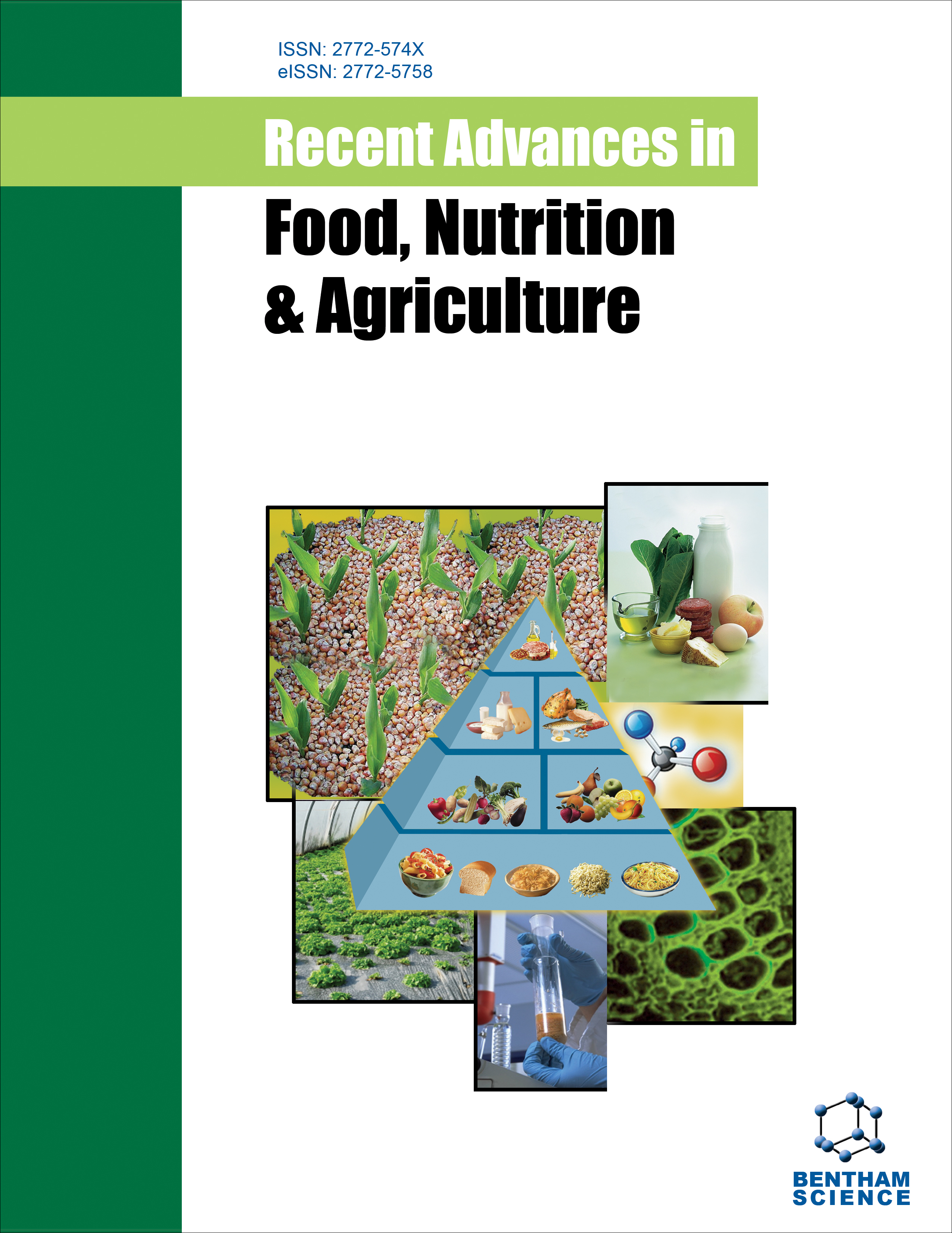- Home
- A-Z Publications
- Recent Advances in Food Nutrition & Agriculture
- Previous Issues
- Volume 13, Issue 1, 2022
Recent Advances in Food Nutrition & Agriculture - Volume 13, Issue 1, 2022
Volume 13, Issue 1, 2022
-
-
Phytochemicals as Potential Inhibitors of Advanced Glycation End Products: Health Aspects and Patent Survey
More LessBackground: The glycation of proteins and lipids synthesizes the advanced glycation end products (AGEs), i.e., substances that irreversibly damage macromolecules present in tissues and organs, which contribute to the impairment of biological functions. For instance, the accumulation of AGEs induces oxidative stress, the inflammatory responses, and consequently the on set/worsening of diseases, including obesity, asthma, co Read More
-
-
-
Therapeutic Effects of Gut Microbiota on Metabolic Syndrome: A Patent Review
More LessAuthors: Shivani Singhal and Vibha RaniBackground: The balanced composition of the gut microbiota is essential for human health. The dysbiotic condition may develop various complex diseases. A metabolic syndrome is a group of biochemical and physiological abnormalities that can increase the risk of cardiovascular diseases, diabetes, and inflammatory diseases. It has become a serious concern worldwide because there is no acceptable medication to overco Read More
-
-
-
Drug-food Interactions in the Era of Molecular Big Data, Machine Intelligence, and Personalized Health
More LessAuthors: Romy Roy, Shamsudheen Marakkar, Munawar P. Vayalil, Alisha Shahanaz, Athira Panicker Anil, Shameer Kunnathpeedikayil, Ishaan Rawal, Kavya Shetty, Zahrah Shameer, Saraswathi Sathees, Adarsh Pooradan Prasannakumar, Oommen Kaleeckal Mathew, Lakshminarayanan Subramanian, Khader Shameer and Kamlesh K. YadavThe drug-food interaction brings forth changes in the clinical effects of drugs. While favourable interactions bring positive clinical outcomes, unfavourable interactions may lead to toxicity. This article reviews the impact of food intake on drug-food interactions, the clinical effects of drugs, and the effect of drug-food in correlation with diet and precision medicine. Emerging areas in drug-food interactions are the food-geno Read More
-
-
-
Antimicrobial, Pesticidal and Food Preservative Applications of Lemongrass Oil Nanoemulsion: A Mini-Review
More LessAuthors: Deepika Balasubramanian, Agnishwar Girigoswami and Koyeli GirigoswamiBackground: Essential oils that are extracted from plants have shown beneficial effects on humans and animals, evidenced by traditional medicine. They possess many essential phytocomponents that act as antimicrobial agents, and most of them are safe for external usage. Introduction: Lemongrass essential oil is extracted from the grass, such as Cymbopogon flexuosus, and is used for antimicrobial activity for a long tim Read More
-
-
-
A Patent Data Analysis of the Innovation Trends in Biological Control Agent Formulations
More LessBy Ahmed FatimiBackground: Biological control (i.e., biocontrol) can be defined as the use of microbial inoculants with a direct and purposeful manipulation of natural enemies, potentially replacing harmful pesticides, to control pests, plant pathogens, and weeds. This study concerns patent analysis of biocontrol agent-based formulations. This form of patent analysis encapsulates information that could be used as a reference by resear Read More
-
Most Read This Month
Article
content/journals/rafna
Journal
10
5
false
en

Most Cited Most Cited RSS feed
-
-
Drug-food Interactions in the Era of Molecular Big Data, Machine Intelligence, and Personalized Health
Authors: Romy Roy, Shamsudheen Marakkar, Munawar P. Vayalil, Alisha Shahanaz, Athira Panicker Anil, Shameer Kunnathpeedikayil, Ishaan Rawal, Kavya Shetty, Zahrah Shameer, Saraswathi Sathees, Adarsh Pooradan Prasannakumar, Oommen Kaleeckal Mathew, Lakshminarayanan Subramanian, Khader Shameer and Kamlesh K. Yadav
-
-
- More Less

